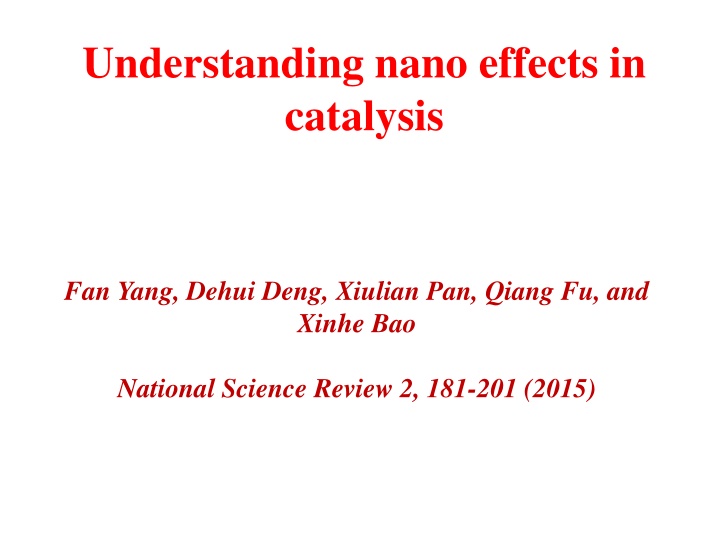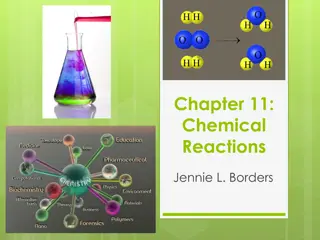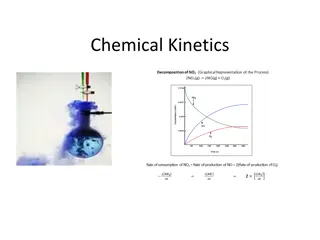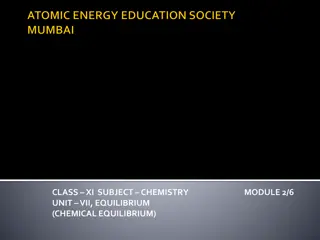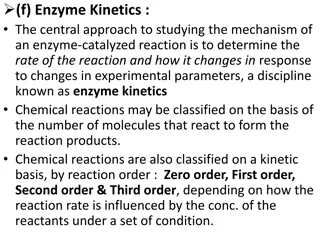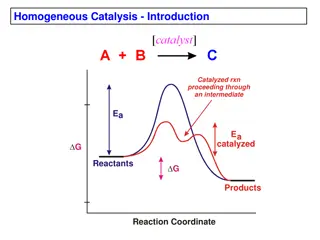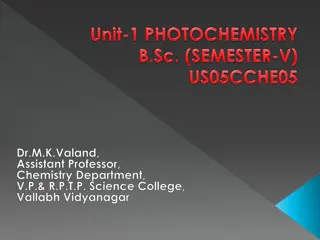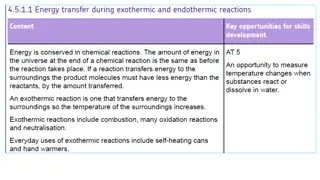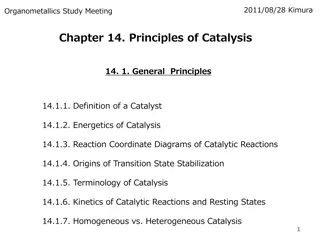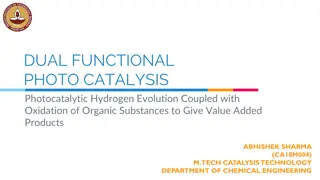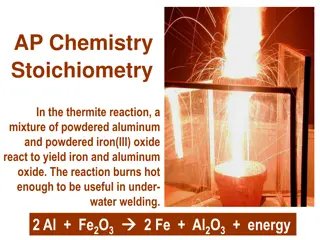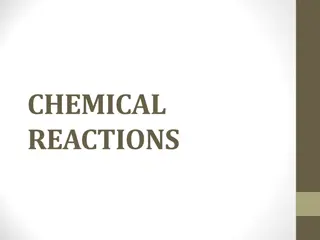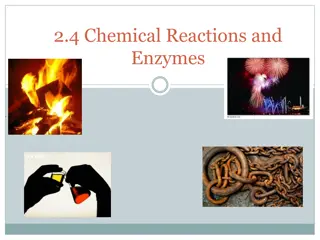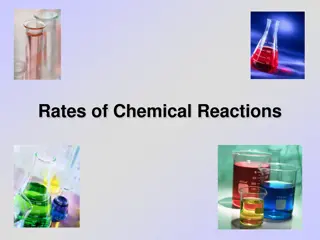Nano Effects in Catalysis: Enhancing Chemical Reactions
Catalysis plays a crucial role in various sectors of the economy, including energy conversion, environmental protection, and health. Advances in catalysis involve manipulating catalysts at the nano level to control reaction pathways and product selectivity. Understanding electron transfer mechanisms and catalyst surface interactions is key to enhancing catalytic properties and efficiency. Researchers aim to optimize catalyst design and processes to achieve high selectivity and efficiency under mild conditions, leading to breakthroughs in energy conversion and resource utilization.
Download Presentation

Please find below an Image/Link to download the presentation.
The content on the website is provided AS IS for your information and personal use only. It may not be sold, licensed, or shared on other websites without obtaining consent from the author.If you encounter any issues during the download, it is possible that the publisher has removed the file from their server.
You are allowed to download the files provided on this website for personal or commercial use, subject to the condition that they are used lawfully. All files are the property of their respective owners.
The content on the website is provided AS IS for your information and personal use only. It may not be sold, licensed, or shared on other websites without obtaining consent from the author.
E N D
Presentation Transcript
Understanding nano effects in catalysis Fan Yang, Dehui Deng, Xiulian Pan, Qiang Fu, and Xinhe Bao National Science Review 2, 181-201 (2015)
Catalysis has been a core technology for many aspects of national economy, including petroleum refining, synthesis of fertilizers and other chemicals, and pollution control optimal utilization of natural resources The chemical industry, which is closely related to energy conversion, the environment, agriculture and health, is thus facing a major change, perhaps even a revolution.
conversion of coal to natural gases, basic chemicals and liquid fuels, and the utilization of clean and renewable energy sources, including H2 O2 fuel cells, solar energy, biomass conversion and the conversion of CO2. on the activation and transformation of small molecules, with an emphasis on the control of catalysts and catalytic processes and the pursuit of 100% product selectivity under mild reaction conditions. These changes depend on the development of new theories and methods in various aspects of catalytic research, such as catalyst preparation, theoretical simulation of catalytic processes, in situ characterization of catalysts and catalytic processes, and the scaling- up and industrialization of catalytic processes.
Tailoring catalysts and catalytic processes have long been the Holy Grail of catalytic chemistry indeed, of much of chemistry as a whole. Research in catalysis over the past century has made it clear that key elementary steps of catalytic reactions, such as the adsorption of reactants, the diffusion of intermediates and the desorption of products, all involve electron transfer between the catalyst surface and the reactive species. Tuning of the spatial and energy distribution of valence electrons at the catalyst surface can thus be used to directly control catalytic properties such as the activation energy barrier, which determines the reactivity and the selection of reaction pathways, and thus product selectivity . In principle, frontier molecular orbital theory can provide an understanding of key steps involved in surface catalytic reactions. The theory indicates that the strength of the adsorption and bonding of reactants on catalyst surfaces is closely related to the symmetry and spin state of reactant s molecular or atomic orbitals, and depends on matching the energy levels of the reactants to those of the catalyst surface as well.
For a long time, researchers tried to influence and adjust the surface structure and electronic state of a catalyst surface by mixing additives with the primary catalytic components, thus enhancing catalytic performance. Since the development of surface science from the middle of the last century, scientists have come to realize that even different faces of the same crystal could have a significantly different distribution of valence electrons due to their different atomic arrangements and interactions. This difference can lead to variations in molecular adsorption and reactivity on different crystal faces . Norskov and coworkers invoked a so-called d-band center theory based on a large body of experimental and theoretical results, which emphasizes that the density of d-band valence electrons near the Fermi level is an important factor affecting catalytic reactions.
Meanwhile, the unique physical and chemical properties of nanoparticles (NPs) introduced with the development of nanoscience have attracted wide attention in a number of fields, including catalysis . Valence electrons in bulk metals form continuous bands. When the bulk material is reduced in a certain direction down to the nanometer scale, the motion of electrons in this direction is subjected to confinement. Compared to bulk metals, NPs exhibit much larger total exposed surface areas and various combinations of surface structures, and electronic confinement effects within NPs may lead to major changes in the electronic structure (Fig. 1). This raises the possibility of tuning the catalytic process. In this sense, nanotechnology could provide an effective means through which we can effectively and quantitatively control the surface structure and electronic properties of supported nano catalysts without changing their composition. It is thus hoped that adsorption and catalytic reactions can be optimized by continuously adjusting the size of catalysts at the nanometer scale.
Size effects in NPs have been noticed since the infancy of catalytic research, for example, through studies of ultrafine particles and single- site catalysts . It has long been found that catalytic activities often increase with decreasing size of catalyst particles. However, it was traditionally thought that a decrease in particle size simply causes an increase in the proportion of surface species that are catalytically active, and also an increase in surface defects: these factors were generally considered to be primarily responsible for the size effect. But the development of nanoscience has led to an awareness that in addition to the increase in surface area and heterogeneity of atomic structure, catalytic NPs exhibit quantum size effects in their electronic nature. Moreover, nanoscale pores also show unique electronic confinement effects . Therefore, the marriage between nanoscience/ nanotechnology and catalysis brings huge opportunities for the development of catalysis.
In recent years, there has been great progress in understanding nanoscale catalysts for example, the effects of particle size and morphology, and the catalytic properties of 2D materials, nanophases of carbon and nanoporous materials. By tuning the morphology of catalysts at the nanoscale, one can quantitatively design and preferentially expose crystal faces that are highly active, thereby increasing the surface density of active sites (Fig.2).
Or one can reduce the size of catalytic NPs to a single atom or a pseudo-single atom, thereby maximizing the catalytic activity of active components (Fig. 3) . These studies have deepened our understanding both of nano effects in catalysis and of catalytic mechanisms in related processes. In the past two decades, many groups have focused on the effect of confined electrons on the catalytic properties of nanosystems. We have systematically studied the correlation between the structures/electronic states and the catalytic properties of nanocatalytic systems, including nano-sized molecular sieves , nano-carbon materials and nano-oxide materials , which are used in the conversion of carbon monoxide, syngas and methane.This presentation summarizes our experimental and theoretical results on how the nano effects play a role in tuning the electronic structure and subsequently the catalytic properties in such confined catalytic systems. We further elaborate on the concept of the confinement effect in nanocatalysis .
CATALYSIS WITHIN CARBON NANOTUBES AND THE SYNERGETIC CONFINEMENT EFFECT Carbon has been widely used as an adsorbent and catalytic material since synthetic forms of carbon were developed almost a century ago. Significant progress has been made over the years, both experimentally and theoretically, in controlled synthesis and in understanding the structures and catalytic properties of carbon materials including fullerenes, carbon nanotubes (CNTs), graphene, mesoporous carbon and activated carbon. . Catalysis by nanostructured carbon materials, especially CNTs, has received wide attention. Research groups, including those led by Centi, Schloegl, Serp and Su, have carried out extensive investigations on the acidity and basicity of oxygen-containing functional groups (e.g. hydroxyl, carboxyl and amino groups) at the edges and defect sites of nanostructured carbon, and their correlation with catalytic performance. For instance, Schloegl and coworkers demonstrated that the oxygen atoms on the defect sites of the outer surface of CNTs play a crucial role in the dehydrogenation of ethylbenzene.
CNTs can be envisioned as graphene layers rolling up to form a well- defined tubular structure. The electron density of the graphene layers shifts from the concave inner surface to the convex outer surface because of the curvature, resulting in an electron potential difference across the CNT walls . This endows CNTs with unique physico- chemical properties, distinct from other, conventional carbon materials. Fig. 4 shows the electron potential difference between the concave and convex surfaces as a function of the CNT diameter, calculated from a simple model. A potential difference as high as 0.20 eV is estimated for a nanotube with a diameter of 1.36 nm, causing a strong electric field in the nanospace. Thus, if catalytic NPs are placed within such an environment, the nanospace not only exerts a physical restriction on them (and on the reactions they facilitate), but also provides a unique electronic micro-environment that modulates electron transfer processes.
A variety of methods have been reported to disperse NPs within the channels of CNTs .We have developed an efficient approach for catalytic applications, which allows homogeneous dispersion of various metal NPs in CNTs with different diameters . Briefly, the technique involves several steps (Fig. 5), including purification and cutting of long as-synthesized CNTs, followed by filling with NPs. In the first step, silver or iron NPs may be dispersed onto the outer walls of CNTs as oxidation catalysts, which could introduce defects on the surface of CNTs through controlled oxidation. Long nanotubes are then shortened to the desired length (typically 100 500 nm) by cleaving them at these defects through etching with HNO3.With ultrasound treatment, we are then able to introduce metal and metal oxide NPs efficiently into the CNT channels, usually with more than 75 85% of the particles located inside. The size of the NPs depends on the diameter of CNTs: for example, particles of 2 5 nm can be usually obtained within nanotubes with an inner diameter of 4 8 nm (Fig. 6 upper), while subnanometer-sized particles (<1 nm) are dispersed within the channels of single-walled CNTs (SWCNTs) and double-walled CNTs with inner diameters of 0.8 2 nm.
The capability of CNT channels to modulate the properties and behavior of confined molecules and nanomaterials is receiving increasing attention. Alterations in crystal structures, in chemical bonding and even in chemical state are frequently reported For example, we demonstrated the reduction of Fe2O3 NPs confined within CNTs: confinement in CNTs with an inner diameter of 4 8 nm leads to a reduction temperature 200oC lower than that required for Fe2O3 NPs on the outer walls of the same CNTs, as revealed by in situ transmission electron microscopy (TEM) and X-ray diffraction measurements . Further studies showed that the reduction temperature lowers in a stepwise manner with decreasing inner diameter of CNTs (Fig. 6 ). Moreover, the oxidation of metallic Fe NPs is hindered by confinement: the apparent activation energy for oxidation is 4 kJ mol 1 higher than it is for the same NPs on the outside of the CNTs, suggesting that the oxidation rate (corrosion) can be retarded by confinement. Density functional theory (DFT) calculations on Fe9 clusters have provided insights into the underlying mechanism .
The d band states of the encapsulated clusters are shifted downwards due to the strong interaction of the clusters with the interior surface of the CNTs, reflected in pronounced strain and deformation within the confined nanospace. As the effective d-band centers affect the occupancy of antibonding states of adsorbed O atoms , a lower d-band center would lead to more occupancy. This results in weaker binding of O atoms, implying that the encapsulated Fe clusters are more difficult to oxidize, while encapsulated iron oxide clusters are correspondingly easier to reduce. Such a unique confined environment also shifts the volcano-shape correlation between the catalytic activity and the dissociative binding energies of reactants, towards the metals with higher binding energies. The extent of the shift can be well described by the confinement energy, which depends on the specific metals and the CNT diameters (Fig. 7).
The modified redox behavior of confined metal or metal oxide NPs can affect their catalytic activity directly, as redox reactions involve electron transfer between reactants and catalysts. For syngas conversion to liquid fuel over an iron catalyst, confined Fe nanocatalysts exhibit a much higher activity, and the yield of C5+ hydrocarbons is almost twice as high, compared with the same catalyst particles on the exterior of the tubes. Detailed characterization reveals that the confinement facilitates formation of catalytically active iron carbide species under reaction conditions due to the modified redox behavior of confined iron (Fig. 8a and 8b)
Confinement is also found to enhance the catalytic activity of a bi- component RhMn catalyst in syngas conversion to C2 oxygenates . One-step synthesis of C2 oxygenates, including the production of ethanol from syngas, remains a challenge for catalytic production of fuel. It relies on noble metals such as Ru and Rh as catalysts, but the efficiency of the process is still too low for commercialization. Our preliminary results show that this reaction benefits from confinement of RhMn NPs within CNTs, evidenced by a significantly enhanced yield of C2 oxygenates with respect to the catalyst on the outside, because of better adsorption and dissociation of CO molecules on reduced RhMn sites (Fig. 8c and 8d) Based on such systematic experimental characterization and theoretical calculations, we propose that the well-defined nanoscale channels of CNTs, with their unique electronic structure, provide an intriguing confinement environment for catalysis, which can be understood on the basis of considerations additional to the electronic confinement effects.
Spatial restriction The size and shape of NPs can be affected within the nanospace of CNTs. As a result, NPs can be dispersed there more homogeneously, with a uniform size. For example, within SWCNTs with a diameter of 1.3 nm, we have achieved dispersion of Re NPs of 0.4 nm (each consisting of around 50 metal atoms). These subnanometer-sized Re particles exhibit enhanced catalytic activity in low-temperature ammonia synthesis
Enrichment of molecules The nanochannels composed of sp2 hybridized carbon exhibit hydrophobic properties, in addition to the electron-deficient environment. Thus, it can be expected that hydrophobic and nucleophilic molecules will tend to adsorb and gather inside the channels. Enrichment of hydrogen has been reported inside CNTs, stimulating wide interest in their use as hydrogen storage materials. A hydrogen storage capacity of 1.8 wt% has been reported, although the feasibility of using CNTs as efficient hydrogen storage materials has yet to be established. Our theoretical calculations show that not only H2 but also N2 and CO can be enriched within CNT channels. For example, at 300 K and 1 MPa, CO is enriched by 20 times within a (10,10) nanotube: in effect this means that the CO pressure within the CNT channel is enhanced by a factor of 20 in an external CO atmosphere of 1 MPa . This finding might make it possible to conduct reactions that conventionally require high pressures under much milder conditions. We recently presented experimental studies on the selective enrichment of molecules with different properties in solution . Our in situ high-resolution nuclear magnetic resonance (NMR) studies demonstrated that CNT channels can selectively absorb hydrophobic benzene relative to hydrophilic acetic acid and phenol molecules. Benzene tends to diffuse into the CNT channels, leading to locally higher concentration. Consequently, the rate of benzene conversion to phenol is enhanced 4 fold using a CNT- confined Re catalyst, relative to the same catalyst dispersed on the outer walls of the CNTs. This is not just because of local enrichment of benzene inside the CNT channels but also selective expulsion of hydrophilic phenol molecules. CNT-based catalysts may thus find applications in high-pressure reactions such as the conversion of syngas to light olefins and ethylene glycol via C-C bond coupling, as well as low-pressure ammonia synthesis and some selective oxidations.
